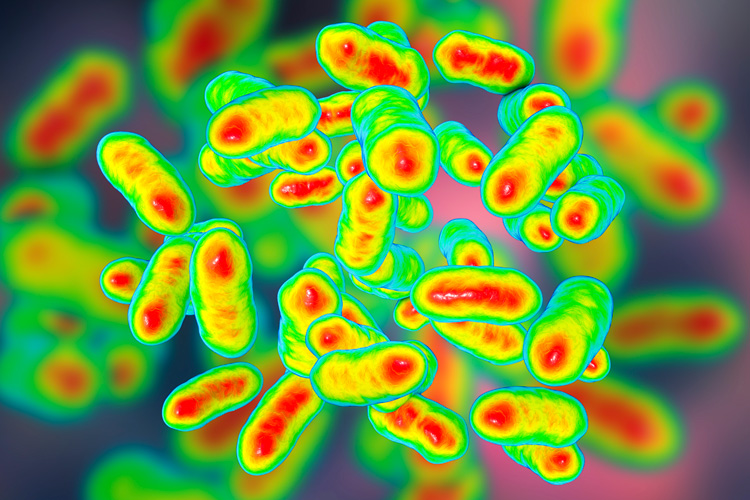Pulmonary Immune Dysregulation and Viral Persistence During HIV Infection


Viruses plague bacteria just as viruses like influenza plague humans.
Some of the largest of these so-called bacteriophages have now been found in the human gut, where they periodically devastate bacteria just as seasonal outbreaks of flu lay humans low, according to a new study led by UC Berkeley scientists.

Prevotella copri, a type of bacteria found in the human gut, primarily in people who eat a high-fiber, low-fat diet. The largest bacteriophages ever found in humans prey on Prevotella bacteria. (iStock image)
These “megaphages” — which have genomes about 10 times larger than the average phage and twice as big as any phage previously found in humans — were found in the human intestinal tract, but only from humans who eat a non-Western, high-fiber, low-fat diet.
Tellingly, they were also found in the guts of baboons and a pig, demonstrating that phages — which can carry genes that affect human health — can move between humans and animals and perhaps carry disease.
“Phage are well-known to carry genes that cause disease and genes that code for antibiotic resistance,” said Jill Banfield, who leads the Innovative Genomics Institute’s microbiology initiative and is a UC Berkeley professor of earth and planetary science and of environmental science, policy and management. “The movement of megaphages along with the movement of their host bacteria raises the possibility that disease also can move between animals and humans, and that the capacity for this is much larger with megaphage.”
And because most biologists do not consider viruses to be “living,” the fact that megaphages are bigger than lifeforms like bacteria blurs the distinction between what is alive and what isn’t.
“These huge entities fill the gap between what we think of as non-life and life, and in a sense, we have mostly missed them,” Banfield said.
Banfield and her colleagues reported their findings online Jan. 28 in the journal Nature Microbiology.
Banfield is a pioneer of metagenomic sequencing, that is, simultaneously sequencing all the genes from a soup of all the organisms in a community. She and her colleagues then reconstruct the genomes of each creature in the community, often turning up microbes never before seen. By exploring microbial communities in mine runoff, geysers, the human intestinal tract and deep underground, she has discovered so many new microbes through metagenomic sequencing that the tree of life has had to be redesigned to accommodate them all.

Through grooming and other social interactions, baboons share fecal bacteria and the bacteriophages that prey on them. Megaphages are shown exaggerated in size atop feces in lower left. (Joyce Powzyk image)
In the process, she has uncovered many genes of bacteriophage, as phage are formally known. In fact, the CRISPR cluster found in some bacteria is a reservoir of phage genome fragments that the bacteria keep to remind them of previous phage infections, allowing them to quickly fend off subsequent infections by the same phage. The Cas9 protein mobilized by these bacteria to target and cut up viral invaders was adapted by UC Berkeley and University of Vienna scientists as a powerful tool, CRISPR-Cas9, that has revolutionized biology and revitalized the field of gene therapy.
While sequencing gut bacteria from people in Bangladesh — part of a study led by collaborator Joanne Santini of University College London to explore the effects of arsenic-tainted water on intestinal flora — Banfield identified these megaphages. Once she had reassembled their entire genomes, she saw that all of them were 10 times bigger than the average phage encountered in other microbiomes. To accommodate these phages’ bloated genomes, their packaging, called a capsid, is presumably larger than those of other known phages, possibly between 200 and 300 nanometers across.
She and her colleagues found a CRISPR segment in one type of bacteria, Prevotella, that contained snippets of megaphage DNA, suggesting that the megaphage prey on Prevotella primarily. Prevotella is not common in people eating a Westernized diet, with lots of meat, fat and sugar, and fewer gut microbiomes from those eating a non-Western, “hunter-gatherer” type of diet have been sequenced.
Prevotella is also associated with upper respiratory tract infections and is prevalent in periodontal disease, according to coauthor Joanne Santini. This means the new megaphage may open up the development of new phage-based treatments for infections caused by Prevotella.
Banfield and her team named the group or clade of megaphages “Lak phage” after the area of Bangladesh where they found them, Laksam Upazila. Subsequently, first author Audra Devoto found Lak phages in the gut microbiomes of members of the hunter-gatherer Hadza tribe of Tanzania, in two separate social groups of baboons that had been studied in Kenya and in the gut microbiota of pigs from Danish farms.

A study of the microbiomes of Bangladeshis like these, who suffer from illnesses caused by arsenic-tainted water, revealed a new class of megaphages targeting the bacteria in their guts. (University College London photo byJoanne Santini)
“The Lak phages in the pig are more closely related to humans than baboons are, so it’s quite probable that these phages are moving across animal cohorts,” Banfield said. “We suspect that the Prevotella and the Lak phage were pretty recently acquired by the baboons, because the baboons have so little resistance to them and they are so widespread among them.”
Phages are known to carry genes that exacerbate many human illnesses. They can carry genes that encode botulism, cholera and diphtheria toxins, for example, making symptoms much worse for those infected with the bacteria. One of Banfield’s goals is to see how populations of phage and the bacteria they prey on in the gut change over time and with diet, and how that affects health.
In the four humans whose gut microbiomes were sampled, the team found changing levels of phage and Prevotella over time, indicating a constant cycle where rising populations of phage drive down bacterial populations, followed by a drop in phage that allows Prevotella to rebound.
Banfield speculates that megaphages have larger genomes in order to produce the proteins necessary to prevent the bacterial host from interfering with the phage’s efforts to make more copies of itself, a process that takes longer because of the bigger genome.
Banfield and her lab in the Innovative Genomics Institute, a joint UC Berkeley/UCSF initiative to widely deploy CRISPR-Cas9, are searching through other metagenomic databases for megaphage, and hope to learn more about how they work and whether they harbor interesting and potentially useful proteins.
“These genomes are full of proteins of unknown function, probably pathways for processes not even imagined to date. There is a lot of new biology to be discovered in these new genomes,” she said.
Former UC Berkeley staff member Audra Devoto is first author of the paper, which also was co-authored by Matthew Olm, Karthik Anantharaman, Brian Thomas and Kimberley Seed of UC Berkeley, Patrick Munk and Frank Aarestrup of the Technological University of Denmark, Jenny Tung of Duke University, Elizabeth Archie of the University of Notre Dame, Peter Turnbaugh of UCSF and Ran Blekhman of the University of Minnesota.
The research was funded by the National Institutes of Health, Sloan Foundation, Chan Zuckerberg Biohub and National Science Foundation.
Comments
Post a Comment